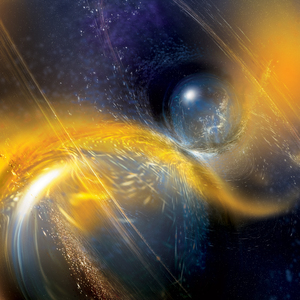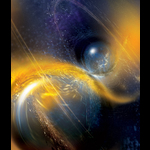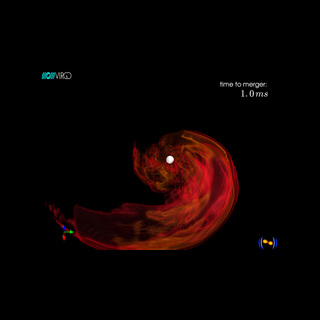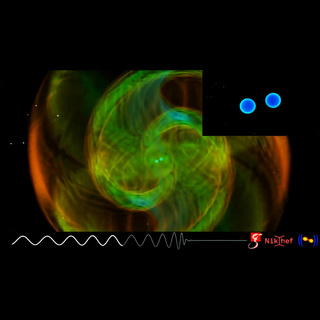Simulation of the neutron star coalescence GW190425
This movie shows a simulation of the binary neutron star coalescence and merger that resulted in gravitational-wave event, GW190425. The two neutron stars in the simulation have properties consistent with those sensed by the Advanced LIGO/Virgo gravitational-wave detectors.
The movie shows the gravitational-wave signal with colors ranging from red, to yellow, green, and blue indicating increasing wave strength, and the densities of the neutron stars in light to dark blue corresponding to 200 thousand to 600 million tons per cubic centimeter, respectively.
Due to the large total mass of GW190425, we believe that the two stars formed a black hole shortly after the merger, unlike the first binary neutron star system from which gravitational waves were detected (GW170817). In addition, the masses of the ejecta matter and the debris disk are significantly smaller than those of GW170817, which makes a detection of an electromagnetic counterpart very unlikely and might explain why no such phenomenon was observed for this event.
The inset at bottom shows how the signal changed in amplitude and frequency over time (the ‘gravitational wave strain’) as sensed by the Livingston detector.
Credit: Numerical Relativity Simulation: T. Dietrich (Nikhef), Wolfgang Tichy (Florida Atlantic University) and the CoRe-collaboration.
Scientific Visualization: T. Dietrich (Nikhef), S. Ossokine, and A. Buonanno (Max Planck Institute for Gravitational Physics)
- Date
- January 6, 2020
- Location
- LIGO Lab
- ID
- ligo20200106v2
- Type
- Simulation
- Credit
- Numerical Relativity Simulation: T. Dietrich (Nikhef), Wolfgang Tichy (Florida Atlantic University) and the CoRe-collaboration







